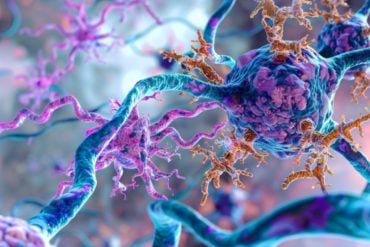Summary: Study sheds new light on how migraines may occur and why those who are susceptible to migraines see improvements in symptoms as they age.
Source: University of Maine
Individuals who experience migraines are prone to a brain energy deficit between attacks, whether through increased demand or inadequate energy production according to a new analysis which finds that an energy impairment may cause brain oxidative stress, triggering a migraine as a protective response.
This analysis sheds light on why migraines occur and helps explain how a migraine aura is kindled and propagates, and why migraines tend to improve as individuals age according to Jonathan Borkum, an adjunct associate professor of psychology at the University of Maine.
Borkum’s analysis, which was published as a review article in the journal Neurochemical Research, characterizes migraines as a homeostatic response set in motion by oxidant-sensing switches in the body that extrapolate individual neuronal metabolism to the entire brain.
When brain energy is inadequate, overproduction of oxidants, which are mild toxins, is stimulated. Borkum hypothesizes that oxidant buildup alerts the brain to the energy imbalance, and elicits the migraine attack as a corrective response. While brain energy deficits have been observed in individuals prone to migraine, the mechanism that triggers an attack based on energy imbalance in the brain was not previously understood.
According to Borkum, the human brain balances the level of antioxidant defense with the amount of energy produced and vice versa, to create a tightly regulated cycle that maintains energy production and cellular redox potential in a narrow optimal range. The oxidative stress created by the energy imbalance associated with migraine threatens neuronal viability in the short term and is suspected as a cause of neurodegenerative disease in the long term.
Borkum demonstrates that energy deficiency, whether resulting from increased energy demand in a hyperexcitable brain or decreased energy supply from mitochondrial impairment, creates oxidative stress as an inherent feature of cellular metabolism. This stress induces migraines in susceptible individuals via oxidant-sensing ion channels in the pain receptors sited in the membrane that covers the brain.

The brain’s response to migraine attacks includes reducing brain energy demands, increasing mitochondrial biogenesis, suppressing apoptosis, releasing varied growth factors, stimulating neurogenesis, reducing the production of reactive oxidative species and raising the level of antioxidant defense.
These protective mechanisms, which seek to balance energy production and demand in the brain, suggest that the migraine attack is itself a corrective process initiated to protect the brain from oxidative stress and energy imbalance.
The implication is that new migraine prevention therapies that treat brain energy deficit and oxidative stress simultaneously will likely be more effective than those that target either separately.
About this migraine research news
Source: University of Maine
Contact: Joan Perkins – University of Maine
Image: The image is in the public domain
Original Research: Closed access.
“Brain Energy Deficit as a Source of Oxidative Stress in Migraine: A Molecular Basis for Migraine Susceptibility” by Jonathan Borkum. Neurochemical Research
Abstract
Brain Energy Deficit as a Source of Oxidative Stress in Migraine: A Molecular Basis for Migraine Susceptibility
People with migraine are prone to a brain energy deficit between attacks, through increased energy demand (hyperexcitable brain) or decreased supply (mitochondrial impairment).
However, it is uncertain how this precipitates an acute attack. Here, the central role of oxidative stress is adduced. Specifically, neurons’ antioxidant defenses rest ultimately on internally generated NADPH (reduced nicotinamide adenine dinucleotide phosphate), whose levels are tightly coupled to energy production.
Mitochondrial NADPH is produced primarily by enzymes involved in energy generation, including isocitrate dehydrogenase of the Krebs (tricarboxylic acid) cycle; and an enzyme, nicotinamide nucleotide transhydrogenase (NNT), that depends on the Krebs cycle and oxidative phosphorylation to function, and that works in reverse, consuming antioxidants, when energy generation fails.
In migraine aura, cortical spreading depression (CSD) causes an initial severe drop in level of NADH (reduced nicotinamide adenine dinucleotide), causing NNT to impair antioxidant defense. This is followed by functional hypoxia and a rebound in NADH, in which the electron transport chain overproduces oxidants.
In migraine without aura, a similar biphasic fluctuation in NADH very likely generates oxidants in cortical regions farthest from capillaries and penetrating arterioles. Thus, the perturbations in brain energy demand and/or production seen in migraine are likely sufficient to cause oxidative stress, triggering an attack through oxidant-sensing nociceptive ion channels.
Implications are discussed for the development of new classes of migraine preventives, for the current use of C57BL/6J mice (which lack NNT) in preclinical studies of migraine, for how a microembolism initiates CSD, and for how CSD can trigger a migraine.







